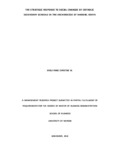| dc.description.abstract | According to Pearce and Robinson (1991) strategic responses are the set of decisions
and actions that result in the formulation and implementation of plans designed to
achieve a firm's objectives. It is thus a reaction to what is happening in the
organization's environment. In 1992 they further stated that strategic responses are
part of competitive strategies that organizations develop in defining their goals and
policies. The external environment is the set of variables including the social aspect,
which is how consumers, households and communities behave and their beliefs. For
instance, change in attitude towards formal education, or greater numbers of people
seeking formal job placements in a population. The social system is the fabric of
ideas, attitudes and behavior patterns that are involved in human relationships. In
particular, businesses are influenced by consumer attitude and behavior which
depend on such factors as age, structure of population and nature of job and leisure,
which are in turn influenced by available disposable income and upcoming needs in
the wider system. Other key factors that affect this are continued positive attitude
and acceptability towards formal education and formal jobs. These are characterized
by growing competition and available opportunities in the job market, changing life
styles from rural and farming to urban and formal jobs. Another key factor is the HIV
and Aids pandemic that has left behind many orphans who need help to make a
livelihood, this calls for a strategic response to all these social changes. The research
design that was used was cross sectional survey which is also known as cross
sectional analysis. This is a research design in which a statistically significant sample
of a population is used to estimate the relationship between an outcome of interest
and population variables as they exist at one particular time. The research used
stratified random sampling technique. A stratified sample survey is whereby the
population is divided or split into different non - overlapping blocks or strata based
on a particular criterion like geographical areas, school types and others. The
random sample was then drawn from each of the strata. The sample consisted of
20% of all secondary schools in the Archdiocese of Nairobi. This was a total of 19
schools, 5 in Nairobi, 7 in Kiambu, and 7 in Thika/Gatundu. The sampling technique
was stratified samples, with geographical divisions forming the strata. The schools
that were sampled were defined by the schools representation in the region as a
percentage of the total schools. The data type that the research collected was
qualitative data from the category questions that sought to get the respondents
response to questions on the variables. The research also had quantitative data in
terms of numbers which were answers to variables like number of intake, increase in
numbers in formal education, costs, and increase in enrollment of other religions in
the schools. The questionnaire were administered to the principal/ Head Teacher
who is a member of the board of governors and also part of the daily running of the
school; the deputy head teacher who is involved in direct running of school; one
member of the teaching staff who sits in the parent teachers association and the
head of the guidance and counseling department. The objective of this study was to
determine the strategic response to social changes by Catholic secondary schools in
the Archdiocese of Nairobi over the last ten years. From the findings in chapter four
and the discussion of chapter five, yes the Catholic secondary schools in the
Archdiocese of Nairobi have responded to the social changes in the environment in a
strategic manner. They have continuously expanded to accommodate more
students; new schools have also been built to cater for growing numbers seeking
formal education. The schools have also made the performance in the standard eight
national exams the main focus when admitting students which gives more
opportunity to all who qualify. The schools have also been admitting students
regardless of religion or family income and supporting them uniformly. The guidance
and counseling, religious formation in school and HIV programs have been
implemented to enhance an all round development of the young student. Majority
of the schools have orphans or even HIV infected students they are supporting since
this is a reality affecting all organization with these institutions of learning not
exempted. | en_US |



